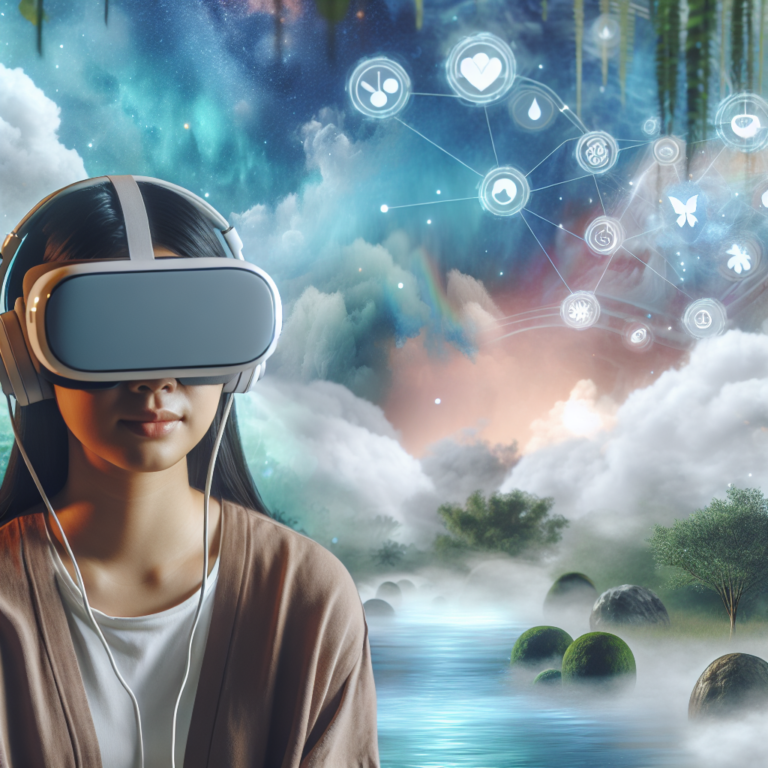Revolutionizing Healing: The Future of Mental Health with Virtual Reality Therapy 🌐
Introduction: A New Era in Mental Health Care
Imagine a world where overcoming anxiety, depression, and trauma doesn’t require you to leave your house. Instead, you simply put on a headset and enter a virtual realm designed to promote healing and well-being. This is not just wishful thinking; it’s the exciting potential of Virtual Reality Therapy (VRT).
As mental health issues become more prevalent, innovative treatments are essential. With advancements in technology, VRT is poised to become the standard for mental health treatment. Let’s delve deeper into the benefits, applications, and future impact of this transformative therapy.
The Mechanics of Virtual Reality Therapy
Virtual Reality Therapy involves immersive, computer-generated environments that simulate real-world experiences. By utilizing VR equipment like headsets and motion sensors, therapists can create tailored therapeutic scenarios where patients can confront and manage their conditions safely.
How VRT Works
- Exposure Therapy: Patients engage with virtual scenarios that replicate their fears, allowing them to confront and desensitize themselves in a controlled space.
- Mindfulness and Relaxation: Users can be guided through soothing environments that promote relaxation, mindfulness, and stress management.
- Cognitive Training: Interactive programs can enhance cognitive flexibility and resilience in individuals struggling with cognitive decline.
The Benefits of Embracing VRT
What if virtual reality therapy became the go-to solution for mental health challenges? The potential benefits are astounding:
Accessibility for All
VRT allows individuals with mobility issues or those living in remote areas to access therapy easily. No longer will location or transportation barriers hinder someone’s mental health journey.
Personalized Therapy Experiences
Therapists can leverage VRT to tailor scenarios specifically for each patient, enhancing engagement and effectiveness. This personalized approach means that individuals can progress at their own pace, facilitating healing in a way traditional therapies may not achieve.
Enhanced Engagement and Motivation
Many individuals may struggle to remain engaged during traditional therapy sessions. VRT’s interactive and immersive nature captivates users, making the process of confronting mental health challenges appear less daunting. The game-like qualities of VRT can even turn therapy into something enjoyable!
Applications Across Mental Health Disorders
The potential applications of Virtual Reality Therapy span a multitude of mental health disorders. Here are a few notable examples:
Anxiety Disorders
Using VRT for anxiety disorders allows patients to encounter simulated anxiety-inducing scenarios, enabling them to face their fears gradually and learn coping mechanisms in a safe environment. Studies show that this method can lead to significant reductions in anxiety symptoms.
Post-Traumatic Stress Disorder (PTSD)
For individuals affected by PTSD, VRT can recreate traumatic events in a controlled manner, allowing patients to process their experiences with therapeutic support. This exposure assists in reprocessing the trauma and reduces its emotional grip.
Phobias
VRT is a popular tool for treating specific phobias. Whether it’s fear of heights or spiders, patients can be gradually exposed to their fears in a virtual context, leading to a measurable decrease in fear response over time.
Depression
Through virtual interactions, users may engage in pleasurable activities they once enjoyed or explore soothing environments, stimulating positive thoughts and feelings amid depression.
Autism Spectrum Disorder (ASD)
For those on the autism spectrum, VRT can help improve social skills by simulating real-life social interactions and environments. This exposure can improve comfort levels and social understanding.
Challenges and Considerations for VRT
Despite its exciting potential, the implementation of Virtual Reality Therapy as a standard treatment for mental health issues comes with challenges. Here are a few considerations:
Cost and Accessibility
As with any cutting-edge technology, the initial costs for development and setup can be prohibitively high. Making VRT affordable and accessible remains a critical hurdle to overcome.
Technical Limitations
Not all patients are technology-savvy. Educating individuals on how to use VR therapy effectively is crucial for its success. Moreover, some may experience motion sickness or discomfort in VR environments, necessitating diversified approaches.
Ethical Considerations
Practitioners must navigate ethical concerns regarding privacy and data security. As VRT employs personal data to tailor experiences, maintaining confidentiality and protecting sensitive information is paramount.
The Bright Future of Mental Health Treatment
The question remains: What if virtual reality therapy became the standard for mental health treatment? The answer lies in the integration of technology with empathy—blending therapeutic practices with innovative VR experiences to enhance mental health care.
Investments in research and development could yield groundbreaking findings, improving countless lives and reshaping the landscape of mental health treatment forever. With the potential to advance accessibility, engagement, and tailored therapeutic approaches, VRT holds the promise of truly transforming lives.
As society continues to embrace technology in daily life, the adoption of Virtual Reality Therapy might not be so far-fetched. In fact, it could pave the way for a brighter, healthier future for mental health treatment, ultimately unlocking pathways to healing and hope for individuals around the globe. 🌍💚




0 Comments